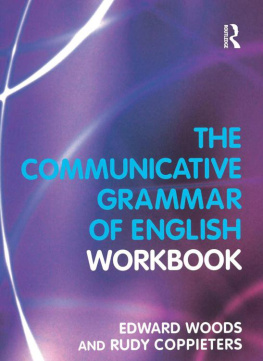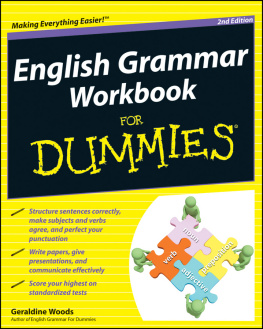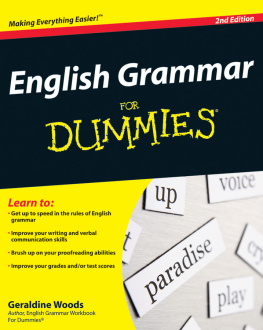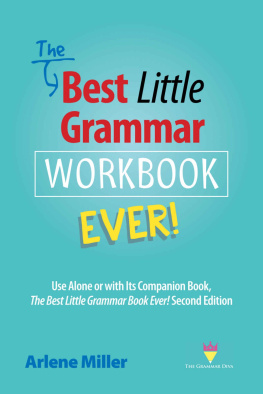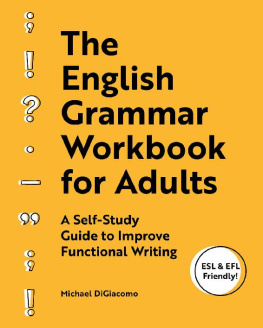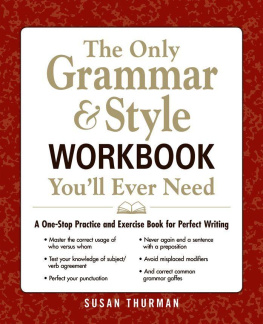Edward Woods - A Workbook to Communicative Grammar of English
Here you can read online Edward Woods - A Workbook to Communicative Grammar of English full text of the book (entire story) in english for free. Download pdf and epub, get meaning, cover and reviews about this ebook. year: 2002, publisher: Routledge, genre: Detective and thriller. Description of the work, (preface) as well as reviews are available. Best literature library LitArk.com created for fans of good reading and offers a wide selection of genres:
Romance novel
Science fiction
Adventure
Detective
Science
History
Home and family
Prose
Art
Politics
Computer
Non-fiction
Religion
Business
Children
Humor
Choose a favorite category and find really read worthwhile books. Enjoy immersion in the world of imagination, feel the emotions of the characters or learn something new for yourself, make an fascinating discovery.
- Book:A Workbook to Communicative Grammar of English
- Author:
- Publisher:Routledge
- Genre:
- Year:2002
- Rating:5 / 5
- Favourites:Add to favourites
- Your mark:
- 100
- 1
- 2
- 3
- 4
- 5
A Workbook to Communicative Grammar of English: summary, description and annotation
We offer to read an annotation, description, summary or preface (depends on what the author of the book "A Workbook to Communicative Grammar of English" wrote himself). If you haven't found the necessary information about the book — write in the comments, we will try to find it.
For the first time A Communicative Grammar of English will have an accompanying workbook. The workbook will help make better use of CGE through providing opportunities for practice and discussion.
A Workbook to Communicative Grammar of English — read online for free the complete book (whole text) full work
Below is the text of the book, divided by pages. System saving the place of the last page read, allows you to conveniently read the book "A Workbook to Communicative Grammar of English" online for free, without having to search again every time where you left off. Put a bookmark, and you can go to the page where you finished reading at any time.
Font size:
Interval:
Bookmark:
The Communicative Grammar of English Workbook
The Communicative Grammar of English Workbook
Edward Woods and Rudy Coppieters

First published 2002 by Pearson Education Limited
Published 2013 by Routledge
2 Park Square, Milton Park, Abingdon, Oxon OX14 4RN
711 Third Avenue, New York, NY 10017, USA
Routledge is an imprint of the Taylor & Francis Group, an informa business
Copyright 2002, Taylor & Francis.
The rights of Edward Woods and Rudy Coppieters to be identified as Authors of this Work has been asserted by them in accordance with the Copyright, Designs and Patents Act 1988.
All rights reserved. No part of this book may be reprinted or reproduced or utilised in any form or by any electronic, mechanical, or other means, now known or hereafter invented, including photocopying and recording, or in any information storage or retrieval system, without permission in writing from the publishers.
Notices
Knowledge and best practice in this field are constantly changing. As new research and experience broaden our understanding, changes in research methods, professional practices, or medical treatment may become necessary.
Practitioners and researchers must always rely on their own experience and knowledge in evaluating and using any information, methods, compounds, or experiments described herein. In using such information or methods they should be mindful of their own safety and the safety of others, including parties for whom they have a professional responsibility.
To the fullest extent of the law, neither the Publisher nor the authors, contributors, or editors, assume any liability for any injury and/or damage to persons or property as a matter of products liability, negligence or otherwise, or from any use or operation of any methods, products, instructions, or ideas contained in the material herein.
ISBN 13: 978-0-582-38181-0 (pbk)
British Library Cataloguing in Publication Data
A CIP catalogue record for this book can be obtained from the British Library
Library of Congress Cataloging in Publication Data
A CIP catalog record for this book can be obtained from the Library of Congress
Typeset in 9/12pt Stone serif by Graphicraft Limited, Hong Kong
Contents
We are grateful to the following for permission to reproduce copyright material:
A. P. Watt Limited on behalf of Jan Morris for an extract from Among the Cities by Jan Morris; Cambridge University Press for extracts from Exploring Spoken English by R. Carter and M. McCarthy (1987); Her Majestys Stationery Office for extracts from The Highway Code; The National Trust Magazine for an extract from The National Trust Magazine No. 95, Spring 2002; Ordnance Survey and Jarrold Publishing for an extract from Pathfinder Guides: Dartmoor Walks by Brian Conduit and John Brooks; Oxford University Press for extracts from Britain by James ODriscoll Oxford University Press 1995; Penguin Books Limited for extracts from Pole to Pole by Michael Palin, and The Brimstone Wedding by Barbara Vine; Saga Publishing Limited for an extract from Saga Magazine February 2002; and World Cancer Research Fund for an extract adapted from Losing weight and keeping it off by Chris McLaughlin published in World Cancer Research Fund Newsletter Issue 45, Winter 2001.
This is the workbook for A Communicative Grammar of English by Geoffrey Leech & Jan Svartvik (3rd edition, published by Pearson Education, 2002). As such, it should be used in conjunction with the grammar.
In this workbook, we have tried to combine the three parts of the grammar. While we have mainly drawn on Part 2 Grammar in Use, we make reference to Part 1 and to Part 3. In some units, these parts are the main focus.
The workbook does not follow the order of the grammar, except insofar as the units follow the order of sections in Part One and Part Two. In general we have used the descriptions of the sections in the grammar as the headings for the sub-units here.
In the contents and at the beginning of each sub-unit, we list the sections referred to in the grammar. The main sections are those in bold at the beginning. The other sections mentioned indicate where reference is made to the topic.
At the beginning of each sub-unit, there is a brief explanation of how a particular structure is formed and/or when it is used, how certain meanings can be expressed, etc. This is based on the explanations in the grammar and users should refer to the main grammar for more detailed explanations and examples.
The nature of the grammar means that the length of the sub-units varies. In some cases there will be several tasks to demonstrate the variety of use, whereas in others there are only a few tasks or even just one.
Tasks vary in nature, ranging from traditional gap filling exercises to rewrite assignments and conversational passages in which the student is invited to participate in an interactive way.
Not all tasks are equally difficult. For the students guidance, each task is followed by one, two or three asterisks, suggesting that it is relatively easy, moderately difficult or quite challenging.
At the end of the book there is an Answer Key. The nature of the grammar means that many tasks will have several possible answers. In these cases we have only suggested answers and others will be possible. Our answers should not be considered the best ones but are only there as a guide.
It is expected that students using this book will be advanced students with a good grounding in the grammar of the language. They now need the opportunity to perfect their skills in the language. They will find this book useful to work on their own and to practise the points raised in the descriptions in the main grammar. Where possible we have tried to use authentic material and to have a variety of different task types.
Teachers can use the book as a grammar course book to give students the extra practice they need. It will also be useful for homework tasks.
Finally, we would like to thank Professor Leech and Professor Svartvik for their support throughout this project. Their careful reading of the manuscript and the comments they made were invaluable and checked any misreading of the grammar we may have made in developing the tasks. We would also like to thank Professor Dr. Dieter Mindt of the Freie Universitat Berlin for making his corpus of the language in use freely available to Edward G. Woods during the semester he was there as a visiting lecturer.
Edward G. Woods and Rudy Coppieters
Spoken and written English
Informal spoken English has many features which, if written down, make it appear rambling and unstructured:
silent pauses, often indicated by a dash (-) in transcription.
voice-filled pauses (e.g. erm) indicating hesitation.
repetition (unplanned repeat, e.g. I I I get)
false starts (e.g. I mean, you know, etc.)
discourse markers and fillers (e.g. well, you see, etc.)
short forms and contractions (e.g. dont, well, gonna)
Task one **
In the following text, underline the features, especially the features of grammar, that show it is spoken language.
Ill tell you a little tale. er- When me mother was alive in Cambridge and -erm-we had some coal delivered me mother was a terror if anything was wrong, you know and er- it got some rocks and bits of scale in it. And I was going. I was quite young then, and she said er- get a, get a, we had a a bag. It was a, quite a strong bag. She said fill it up with some of the coal and stuff. And we got it on the bus and we went all the way to the bottom of Hills Road Bridge. Was er- in fact the buildings still there the coal office. And inside was an old table, an oak er- front. Was about as long as this room. And er- I didnt know what she was going to do with it. Just take it back and probably tell them, you know, the coals not very good. And as she went, she bent down and picked it up and WHOOSH! Straight across the counter. Dust coal everywhere. Take it back, she said. And come back and get the rest of it. They couldnt believe it. I can see their faces today.
Next pageFont size:
Interval:
Bookmark:
Similar books «A Workbook to Communicative Grammar of English»
Look at similar books to A Workbook to Communicative Grammar of English. We have selected literature similar in name and meaning in the hope of providing readers with more options to find new, interesting, not yet read works.
Discussion, reviews of the book A Workbook to Communicative Grammar of English and just readers' own opinions. Leave your comments, write what you think about the work, its meaning or the main characters. Specify what exactly you liked and what you didn't like, and why you think so.

